by Klaus Schroiff, published November 2020
Introduction
Fast standard zoom lenses are incredibly popular in the photographic community – yet the surrounding design challenges in this lens class are about as tough as they get. To date, we haven’t reviewed a single lens of this type that was truly outstanding (on high megapixel cameras). However, that doesn’t mean that they are trying. One of the latest contenders is the Sigma 24-70mm f/2.8 DG DN ART. Sigma wasn’t OVERLY successful with their previous attempts so let’s see whether there’s progress in the mirrorless world. The lens is available both in Sony E and L-mount. One of the easy wins compared to the Sony FE 24-70mm f/2.8 GM is, of course, its price tag. The Sigma is available for around 1100USD/EUR vs 2000USD/1800EUR for the Sony lens.
We have always been a big fan of the mechanical quality of Sigma lenses ever since they introduced the ART/Sports series of lenses – and the Sigma 24-70mm f/2.8 DG DN ART is no exception. The lens body is made of a combination of metal and Sigma’s own TSC (Thermally Stable Composite). ART lenses are targeting professional photographers thus the design is both dust- and splash-proof. The front element also has a water- and oil-repellent coating. On the downside, the lens extends towards the long end of the zoom range – although that’s a fate shared by all lenses in this class. Both the broad zoom ring as well as the smaller focus ring operate smoothly. A petal-shaped lens hood is supplied.

The Sigma 24-70mm f/2.8 DG DN ART uses a noiseless stepping motor for auto-focusing. The AF speed is good although it doesn’t reach the levels of the Sony 24-70mm f/2.8GM. Manual focusing works “by wire”. This works reasonably well in real-life situations although we have seen more precise implementations.
| Specifications | |
|---|---|
| Optical construction | 19 elements in 15 groups inc. 6x FLD, 2x SLD & 3x aspherical elements |
| Number of aperture blades | 11 (rounded) |
| min. focus distance | 0.18-0.38m (max. magnification ratio 1:2.9-1:4.5) |
| Dimensions | 87.8×124.9mm |
| Weight | 830g |
| Filter size | 82mm |
| Hood | petal-shaped (bayonet mount, supplied) |
| Other features | dust- and splash-proof, focus lock button, transport lock |
Distortion
The Sigma 24-70mm f/2.8 DG DN ART produces some fairly strong image distortions in RAW files. Unsurprisingly, the issue is most pronounced at the extreme ends of the zoom range with a barrel distortion of 3.8% at 24mm and a pincushion distortion of 1.5% at 70mm. The two “forces” even out in the lower middle range.
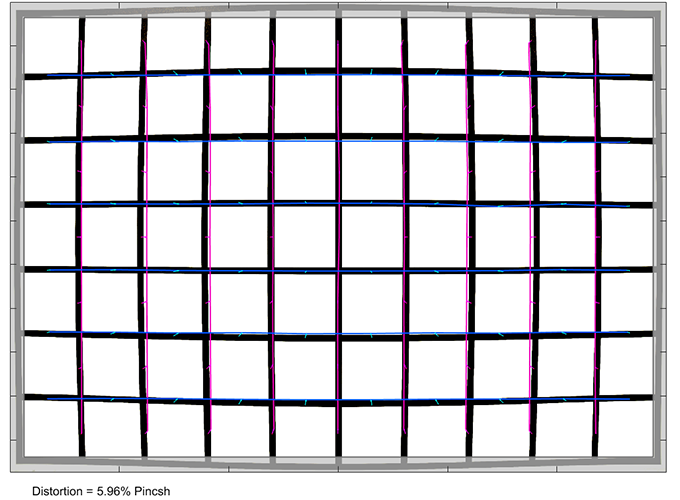
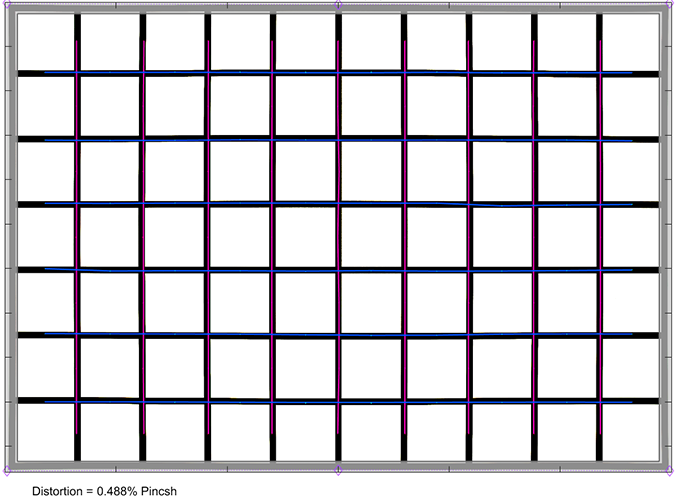
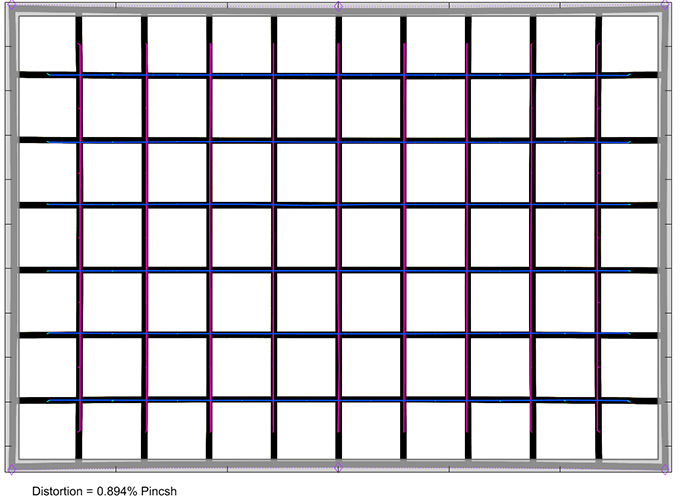
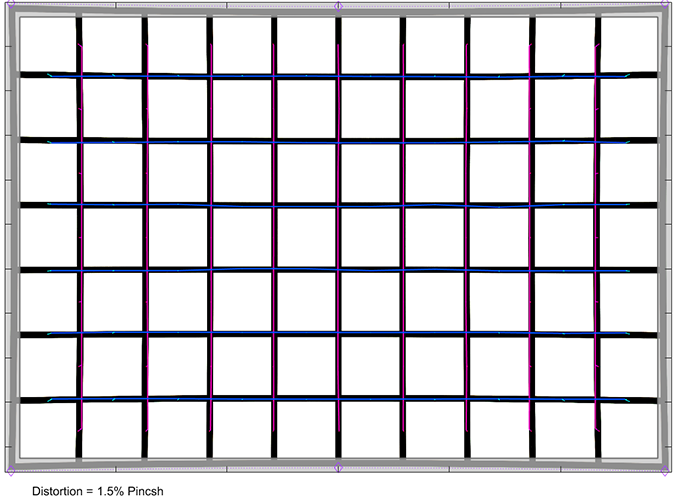
Of course, this is all mostly irrelevant (other than a slight decrease in corner resolution) with activated image auto-correction as you can see below.


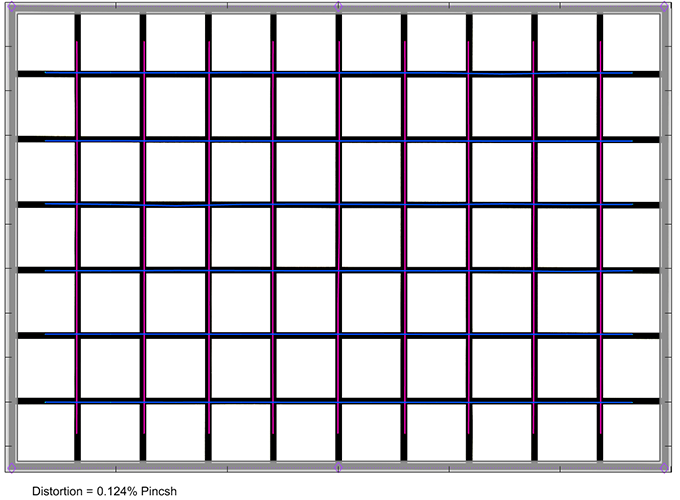

Vignetting
The RAW vignetting characteristic is somewhat worse than expected peaking in a hefty light falloff of 3.6EV (f-stops) at 24mm f/2.8. The issue is just slightly reduced at other focal lengths at f/2.8. Stopping down improves the situation in the 35-70mm range but the vignetting remains heavy at 24mm f/4. The aspect is better at f/5.6 although 24mm remains the weakest spot.
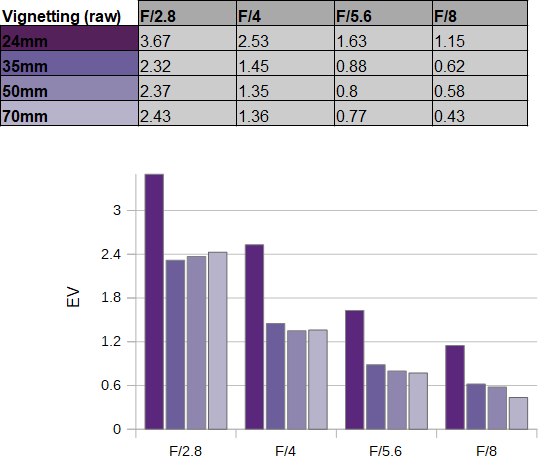
Once again, if you prefer to activate image auto-correction, the algorithm reduces the fall-off substantially although vignetting remains visible at 24mm f/2.8 at least.
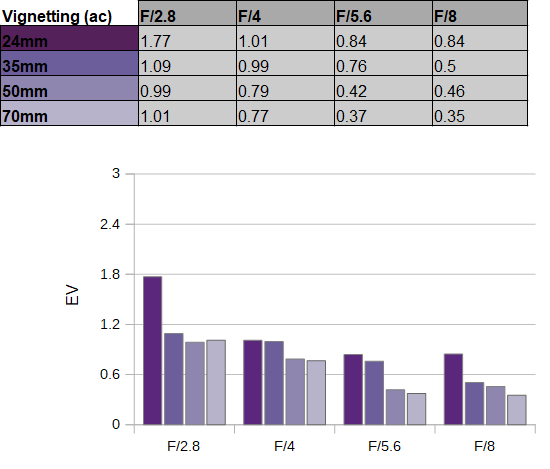
MTF (resolution)
The resolution charts show one of the typical issues that most fast standard zoom lenses still face – consistency. The broader center performance is generally great across the zoom range and especially at wider settings where it certainly exceeds the capabilities of the 42mp sensor used for testing. However, the same can’t be said about the outer image field. The corners are generally quite soft at f/2.8 although the borders are quite good here at least. Stopping down results in a gradual increase in quality with peak quality reached between f/5.6 and f/8. The borders are, overall, very good here and the corners are good to very good.
The field curvature is generally low. The centering quality of the tested sample was very good.
Please note that the MTF results are not directly comparable across the different systems!
Below is a simplified summary of the formal findings. The chart shows line widths per picture height (LW/PH) which can be taken as a measure for sharpness. If you want to know more about the MTF50 figures you may check out the corresponding Imatest Explanations

Chromatic Aberrations (CAs)
Lateral CAs (color shadows in the outer image field) are generally low with an average pixel width around 1px at the image borders. Once again, image auto-correction can basically eliminate this issue and should be kept active due to its lossless nature.

Bokeh
We mentioned it before – a 24-70mm f/2.8 doesn’t really qualify as TERRIBLY fast. Many cheaper prime lenses can easily beat this at lower costs. However, while such lenses may not substitute prime lenses, you can still achieve a fairly decent amount of object separation so let’s check the quality of the bokeh (out-of-focus rendition).
Out-of-focus highlights don’t have a perfectly clean inner zone and there’s a bit of outlining but this is still far superior to other standard zoom lenses. Furthermore, the shape is perfectly circular at f/2.8 and also at f/4. There are just traces of a more edgy aperture shape at f/5.6. This is certainly thanks to the no less than 11(!) aperture blades that Sigma incorporated.

The shape of the highlights tends to deteriorate towards the image borders due to mechanical vignetting. However, the Sigma lens does a really good job here. Only the discs in the far edges are distorted. Stopping down to f/4 recovers those edge discs a bit and they are mostly intact from f/5.6. This is, again, quite a bit better than average.
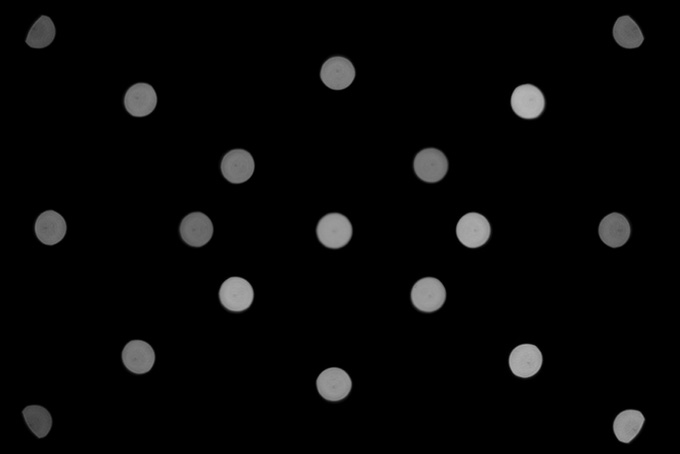
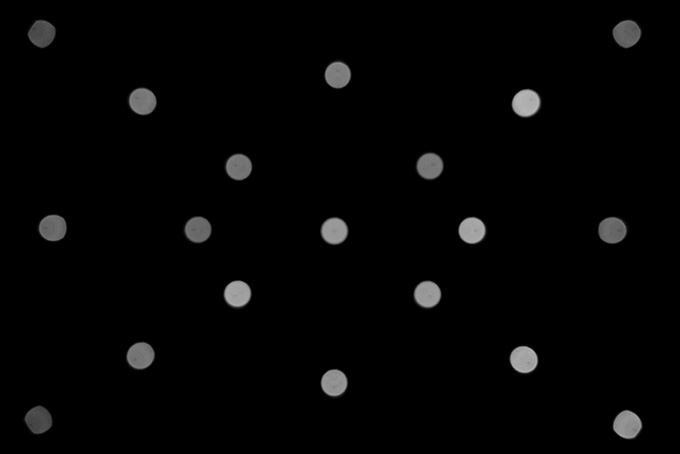
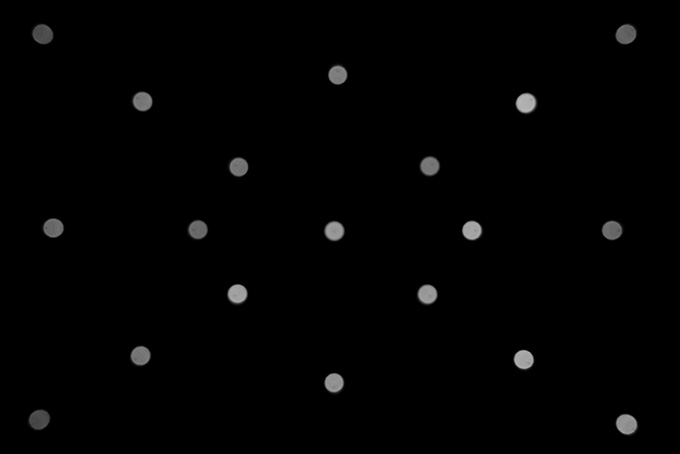
The general rendition in the focus transition zones is very smooth in the background (to the left below). There are some more distinct “shadows” at harsh contrast transitions in the foreground but overall the smoothness is impressive indeed.

Bokeh Fringing (LoCA)
Bokeh fringing – also referred to as LoCAs – is a color fringing effect on the Z-axis. It shows up as purplish halos in front of the in-focus zone and greenish beyond. The effect is clearly visible at f/2.8. Stopping down to f/4 reduces the fringing a bit and it’s still not gone at f/5.6. This is a tad more pronounced compared to others.
Keep in mind that bokeh fringing is normal in all but a handful of very expensive APO lenses.

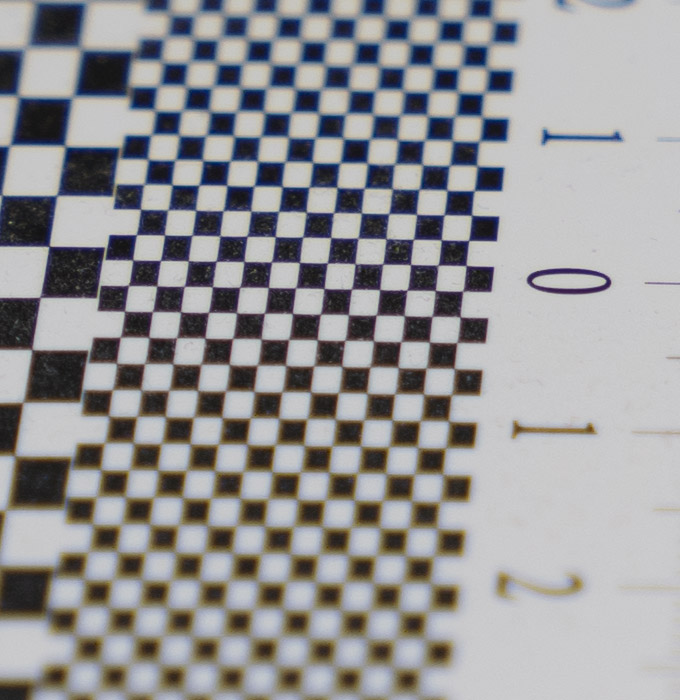
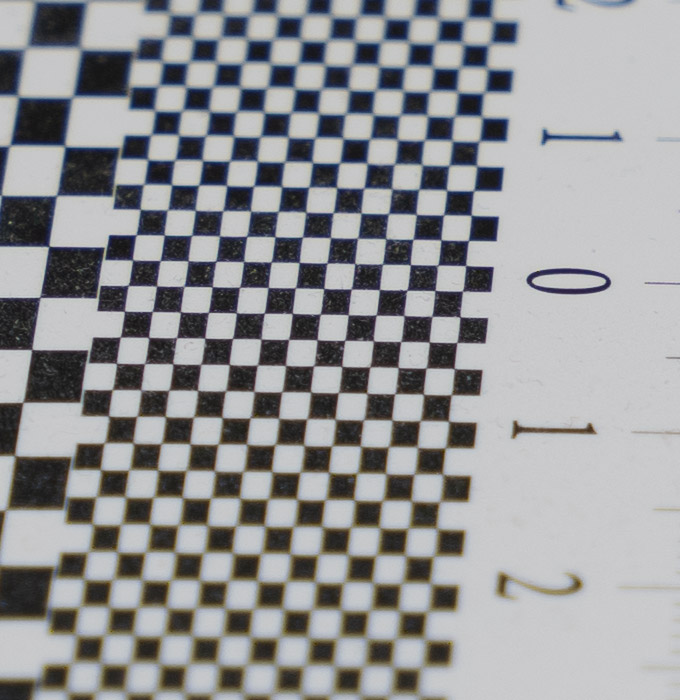
Sample Images
Competition
As of the time of this review, there are currently 3 fast standard zoom lenses competition for your money. Besides the Sigma 24-70mm f/2.8 DG DN (shown to the left below), there’s the already mentioned Sony 24-70mm f/2.8 GM (center) and the Tamron 28-75mm f/2.8 Di III RX (right). The three aren’t WORLDS apart in performance although there are differences. The Sony lens has an edge at the wide end of the range whereas the Sigma is stronger at the long end. The Tamron has the best center quality. Both the Sony and Sigma are clearly better in terms of build quality but they are also much heavier than the Tamron. Unsurprisingly the Tamron is also the most affordable of the 3 although that’s not really surprising given the fact that it stays shy of 24mm. All things considered, the Sigma seems to offer the best overall balance though. And it has, by a fair margin, the best bokeh.

The Sigma 24-70mm f/2.8 DG DN ART shows many of the strengths and weaknesses of a fast standard zoom lens. Don't take this as something negative - it's just how it is. In real life you can expect perfectly sharp results across the image frame at medium aperture settings. At large apertures, the center is ultra-sharp specifically at the wide end but the corners aren't stellar - which is something that you can usually forgive in shallow depth-of-field scenes. That's on high-megapixel cameras. On a 24mp camera, you won't really notice much softness really. Image distortions as well as vignetting are heavy at 24mm but image auto-correction will take care of this (mostly). Lateral CAs are quite low whereas axial CAs are on the high side. A very positive surprise is the quality of the bokeh. Standard zoom lenses are rarely ideal in this respect but the Sigma is as good as most prime lenses in this respect.
Following Sigma's ART line tradition, the build quality is excellent. The materials are top-notch and there's no wobbling to worry about. The lens is also sealed against the elements (dust- & splash-proof). If anything to criticize, it's the extending zoom mechanism but none of the manufacturers has managed to fix this aspect so far. The AF speed is pretty good but remains a little short of the best in class. Needless to say but the camera plays an important role in this respect as well.
If you are in the market for a fast standard zoom lens, the Sigma 24-70mm f/2.8 DG DN ART probably qualifies as the most reasonable choice - especially if you are targeting shallow depth-of-field photography and a quality bokeh.
-
Optical Quality
-
Build Quality
-
Price / Performance


